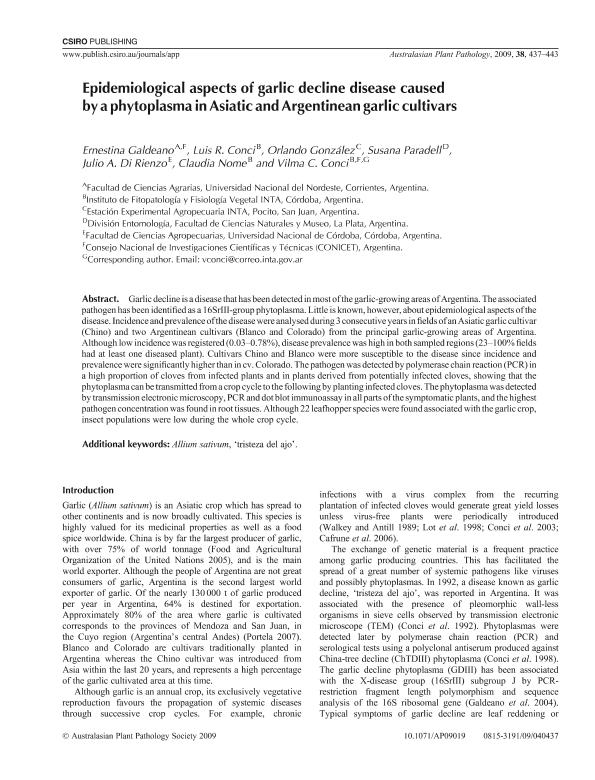Artículo
Epidemiological aspects of garlic decline disease caused by a phytoplasma in Asiatic and Argentinean garlic cultivars
Galdeano, Ernestina ; Conci, Luis Rogelio; González, Orlando; Paradell, Susana Liria; Di Rienzo, Julio Alejandro; Nome, Claudia; Conci, Luis Rogelio
; Conci, Luis Rogelio; González, Orlando; Paradell, Susana Liria; Di Rienzo, Julio Alejandro; Nome, Claudia; Conci, Luis Rogelio
 ; Conci, Luis Rogelio; González, Orlando; Paradell, Susana Liria; Di Rienzo, Julio Alejandro; Nome, Claudia; Conci, Luis Rogelio
; Conci, Luis Rogelio; González, Orlando; Paradell, Susana Liria; Di Rienzo, Julio Alejandro; Nome, Claudia; Conci, Luis Rogelio
Fecha de publicación:
07/2009
Editorial:
Csiro Publishing
Revista:
Australasian Plant Pathology
ISSN:
0815-3191
e-ISSN:
1448-6032
Idioma:
Inglés
Tipo de recurso:
Artículo publicado
Clasificación temática:
Resumen
Garlic decline is a disease that has been detected in most of the garlic-growing areas of Argentina. The associated pathogen has been identified as a 16SrIII-group phytoplasma. Little is known, however, about epidemiological aspects of the disease. Incidence and prevalence of the disease were analysed during 3 consecutive years infields of an Asiatic garlic cultivar (Chino) and two Argentinean cultivars (Blanco and Colorado) from the principal garlic-growing areas of Argentina. Although low incidence was registered (0.03–0.78%), disease prevalence was high in both sampled regions (23–100% fields had at least one diseased plant). Cultivars Chino and Blanco were more susceptible to the disease since incidence and prevalence were significantly higher than in cv. Colorado. The pathogen was detected by polymerase chain reaction (PCR) in a high proportion of cloves from infected plants and in plants derived from potentially infected cloves, showing that the phytoplasma can be transmitted from a crop cycle to the following by planting infected cloves. The phytoplasma was detected by transmission electronic microscopy,PCRand dot blot immunoassay in all parts of the symptomatic plants, and the highest pathogen concentration was found in root tissues. Although 22 leafhopper species were found associated with the garlic crop, insect populations were low during the whole crop cycle.
Palabras clave:
Allium Sativum
,
Tristeza del Ajo
Archivos asociados
Licencia
Identificadores
Colecciones
Articulos(IBONE)
Articulos de INST.DE BOTANICA DEL NORDESTE (I)
Articulos de INST.DE BOTANICA DEL NORDESTE (I)
Citación
Galdeano, Ernestina; Conci, Luis Rogelio; González, Orlando; Paradell, Susana Liria; Di Rienzo, Julio Alejandro; et al.; Epidemiological aspects of garlic decline disease caused by a phytoplasma in Asiatic and Argentinean garlic cultivars; Csiro Publishing; Australasian Plant Pathology; 38; 4; 7-2009; 437-443
Compartir
Altmétricas



